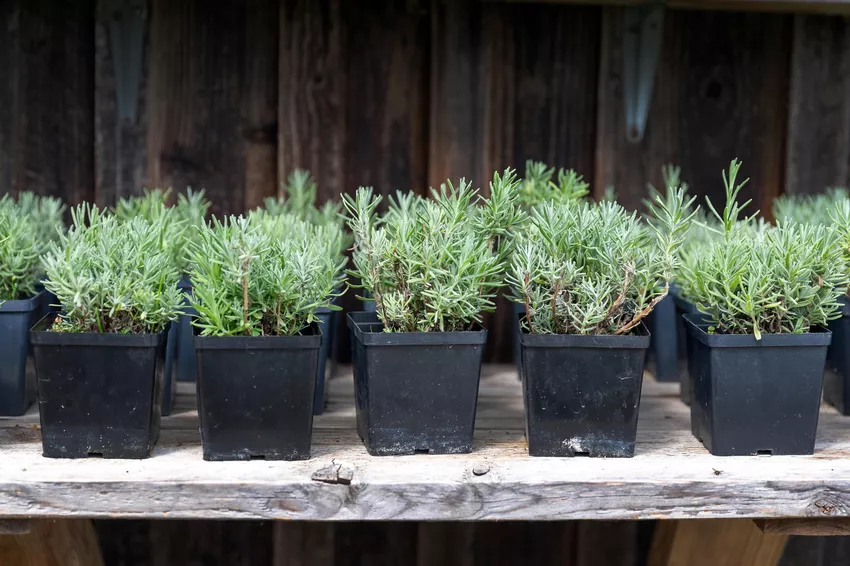Lavender can be propagated in different ways. Whether by cuttings, sowing or division - we will tell you which method is best suited.

The genus of lavender (Lavandula) includes many different species and varieties. However, they all reproduce in a similar way. Contrary to what many people think, lavender is not a perennial, but a subshrub. As such, lavender naturally becomes woody with age. You should therefore rejuvenate your stock sooner or later in order to benefit from the fragrant flowers for as long as possible. Here are three popular ways to propagate lavender. We have also put together general information about lavender for you here.
The most promising method for propagating lavender (Lavandula angustifolia), French lavender (Lavandula stoechas) and Co. is to propagate by cuttings. In principle, sowing is also possible, but this is very time-consuming and involves a lot of work.
Propagating lavender from cuttings
If you don't want to go to the trouble of sowing lavender seeds, you can simply clone your existing plant via cuttings. This method is also known as vegetative propagation. For example, to obtain cuttings, you can use the waste that accumulates when pruning back in spring. To do this, cut young shoots into pieces about 15 cm long with a clean, sharp knife. Then strip off the lower leaves of the branch and place the cuttings about 10 cm deep in nutrient-poor substrate. Peat-free potting soil such as our Plantura organic herb and seed soil is ideal. The soil should always be kept moist without the plant sinking into waterlogging. As a rule, after a few weeks, the first roots form and the small plants can be planted individually in pots.
You can basically plant cuttings all year round. Cuttings planted in spring (end of March) can move outdoors after the ice saints in May at the latest. If yourIf you want to plant lavender cuttings in late summer or autumn, you should definitely protect them from winter.

Propagating lavender from cuttings:
- Cut young shoots into pieces (about 15 cm long)
- Remove Sheets at Bottom
- Put about 10 cm deep in nutrient-poor substrate
- Keep soil moist
- Repot after rooting
Tip from the professional: Woody parts of the lavender plant are no longer suitable for propagation via cuttings.
Propagating lavender by seed
Lavender seeds are commercially available, but usually not of a single variety. Therefore it can happen that the plants from one seed pack look different. This is not a problem with isolated shrubs, but it is much more unpleasant if several plants are to grow next to each other - for example as a hedge or bed edging. In this case, it is best to grow the young plants in a separate bed and sort them out after a year.

In general, propagation of lavender from seeds is usually difficult, as special conditions are required for germination and growth. Lavender germinates in the light, which means the seeds should only be lightly covered with soil. Under optimal conditions, the germination period is about one to two weeks, but can sometimes extend over a few months.
For the propagation, fill small pots with our low-nutrient organic herb and seed soil. If you want the plants to flower for the first time that same year, it is best to plant lavender on the windowsill in early spring (February/March). Sufficient sunlight, moisture and a cover with cling film ensure optimal greenhouse conditions. However, you should remove the film again after four weeks at the latest. Prick out the plants as soon as the first leaves have appeared after the cotyledons. Planting out in the garden is done after the last frost (end of May), when the soil has already warmed up. Direct sowing in the bed is also only recommended after the ice saints in May.
Summary of propagating lavender by seed:
- Fill nutrient-poor herb soil in pots
- Moisten with spray bottle
- Scatter the seeds loosely on the substrate and a littlepush in
- Cover with cling film
- Select bright location
- Remove the foil after about four weeks
- Prick out plants
- Plant in the bed at the end of May at the earliest
Tip from the professional: Lavender forms a lot of seeds when it feels good. You can then carefully transplant the young plants to a desired location. You should dig them out as early as possible so that they can survive the procedure well.
Propagating lavender by division
Perennial plants, which include lavender, can usually be easily propagated by root division. To do this, in spring (March/April) or autumn (September) lift the root ball with a spade and divide it into two pieces. Then plant the parts again at a sufficient distance from each other. However, it should not be planted too densely so that the lavender plants still have enough space to grow.

However, dividing a lavender bush is only possible if it has roots in several places in the ground. Unfortunately, the heavy lignification of older plants often makes the process even more difficult. The wounds in lignified areas caused by sharing are also good entry points for unwanted diseases. Propagation via cuttings is therefore much better suited for most types of lavender.
We have summarized the best way to care for your lavender here.